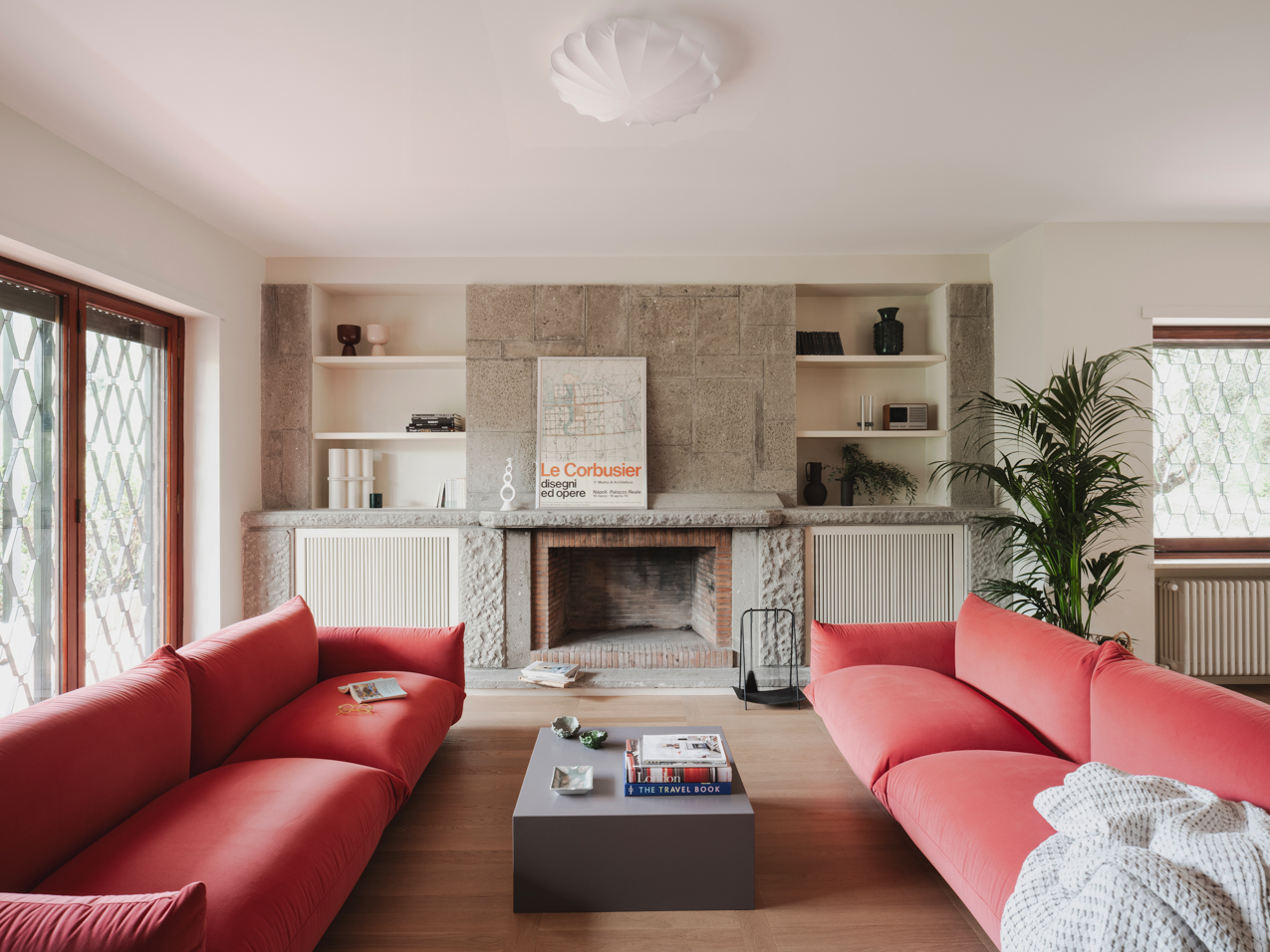This villa is situated in the hills of Castelli Romani, just a short distance from the historic Villa Grazioli. The renovation has transformed it into a timeless modernist retreat.
Originally built in the 1960s, the villa was inspired by Frank Lloyd Wright’s Usonian architecture, featuring clean lines, a simple layout, and the use of natural materials that blend harmoniously with the surrounding landscape.

The villa was originally conceived as a vacation home for a couple who traveled the world for work. It was designed to offer both scenic beauty and respite. Strategically located between Grottaferrata and Frascati, its setting combines the serenity of unspoiled nature with the convenience of being near Rome. For the current owners—Daniele, a senior executive at a tech multinational, and Sara, managing director at a leading consulting firm, along with their three daughters Fiamma, Sole and Celeste—the villa provides a lifestyle closely connected to nature and the benefits of metropolitan life.

The architect maintained this philosophy by preserving the villa’s original architectural elements. At the same time, creative solutions were introduced to strengthen the connection between interior and exterior spaces. Authentic materials such as stone walls, exposed brick, wood, and concrete were kept and reinterpreted. This was achieved by pairing contrasting elements that celebrate natural light and add vitality to the home. The layout was also redefined by removing any corridors and smaller utility rooms, opening the interiors to create smoother connections throughout.
“Throughout the renovation, we emphasized original architectural details that inspired some of the custom furnishings. Take, for example, the kitchen windows and Sara’s upstairs study, both of which feature a central rhomboid motif—a nod to the original 1950s ironwork found throughout the villa. It was a balancing act: this house delivers stimulating and relaxing spaces in equal measure,” explains Matteo Soddu, co-founder of STUDIOTAMAT.

At the entrance, a custom-made wardrobe lined with fabric, featuring elegant Tanganika walnut trim, showcases the architect’s meticulous craftsmanship, reflecting their approach to creating refined, timeless interiors. The original beech wood door (like the windows) has been restored, preserving the villa’s historical essence and deepening its connection to the past. In the living and dining areas, restored stone fireplaces seamlessly blend into the stone walls, creating inviting spaces for socializing and relaxation.

The villa’s elliptical staircase stands as a striking focal point, visible from the entrance, and organizes the ground floor spaces symmetrically. To the east, a stone wall in the living room anchors an integrated fireplace in the conversation. Two large sofas define the TV zone. The guest bathroom is entirely clad in wallpaper with lush and exotic vegetation. It contains a sculptural sink inspired by American design styles of the 1920s and ‘30s. To the west, the 40-square-meter American-style kitchen features a custom-made island in Persian Red Travertine, complete with a cooktop, integrated hood, and teppanyaki plate. The dining nook has a built-in bench under the window, providing an intimate space for small meals. A series of panels conceals refrigerators, pantries, and two hidden passages leading to the service area and secondary stairs. A full-height, powder-coated glass partition gently separates the kitchen from the dining room.

The furniture, selected to reflect the owners’ eclectic personalities, blends vintage pieces with design icons. In the living room, 1970s sofas pair with a pouf/coffee table, while chairs complete the dining room and table. The table’s high-gloss lacquered finish and custom color amplify the room’s natural light, delicately reflecting its surroundings.
Upstairs, the oak parquet floors laid in a “sister” pattern connect the bedrooms, each overlooking the main staircase and joined by a continuous cream-colored resin path. At the center, Sara’s study, with its custom glass wall and large window overlooking the main terrace, serves as a sanctuary of light and inspiration, made cozy by a Tuscan Red-painted ceiling.

In the master bedroom, a wall covered in wallpaper hides the entrance to the en suite bathroom. The bathroom features a freestanding tub and an integrated marble sink creating a luxurious retreat. The daughters’ rooms reflect their personalities, each with custom wardrobes, beds upholstered in cotton velvets, and wallpapers that bring a refined, playful touch. Between the two bedrooms, the shared vanity area, complete with sinks, is distinguished by a custom-built cabinet in dove blue galvanized iron, while the walls are clad in tiles, forming a stylish transition between the rooms, keeping them separate yet connectable.

On the top floor, a loft space revealing breathtaking views of Rome serves as a relaxation and entertainment area. The terracotta rubber flooring defines a cinema and game area where the daughters can enjoy free time in a cozy, laid-back atmosphere, perfect for family relaxation during the winter months.
The architect has created a seamless dialogue between the villa’s original spirit and modern architectural language, applying a sensitive design approach that honors its historical identity while reinterpreting it with a fresh, authentic voice. Every detail, from the natural materials to the tailored furnishings, contributes to a cohesive narrative, where spaces are not merely inhabited but seem to come alive, becoming protagonists in the lives of their residents.
See more images in the gallery below
Project name: A Villa in the Castelli Romani
Project location: Grottaferrata, Italy
Architect: STUDIOTAMAT (Tommaso Amato, Matteo Soddu, and Valentina Paiola)
Project Team: Tommaso Amato, Matteo Soddu, Valentina Paiola, Silvia D’Alessandro
Contractor: Ediltel B
Project assignment: December 2022
Work start: March 2023
Completion: October 2024
Indoor area: 400 sqm
Outdoor area: 3,200 sqm
Photographer: Peter Molloy

